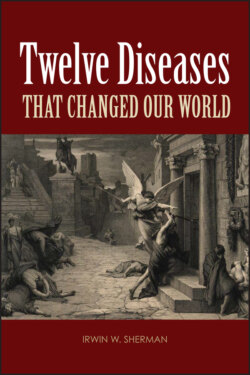Читать книгу Twelve Diseases that Changed Our World - Irwin W. Sherman - Страница 10
“Catching” hemophilia
ОглавлениеHow did Queen Victoria transmit hemophilia to some of her children and grandchildren? Indeed, how did she herself come to be a carrier? Our gender is determined at the moment of fertilization. Each of our somatic (body) cells contains within its nucleus 44 autosomes and one pair of sex chromosomes. During the formation of sperm and eggs, two kinds of sperm are possible (one with an X and one with a Y chromosome) but only one kind of egg occurs (with an X chromosome). Determination of the gender of an offspring depends on the sex chromosome of the fertilizing sperm. If the fertilizing sperm carries an X chromosome, the offspring will be female, and if the fertilizing sperm carries a Y chromosome, the offspring will be male. Genes that are carried on either the X or Y chromosome are called sex-linked genes. The defective gene for hemophilia is carried only on the X chromosome. Since males have only one X chromosome, they have symptomatic hemophilia if they carry the defective form of the gene for factor VIII. However, females, having two X chromosomes, would have to have a double dose of the defective gene to show signs of hemophilia. This is unlikely since the chance of a person having both a hemophiliac father and a carrier mother is quite remote, and females who are hemophiliac die before maturity because the onset of menstruation is fatal.
Hemophiliac fathers pass on the recessive gene to all their daughters but not to any of their sons, because the son receives a Y chromosome, not an X chromosome, from the father. Carrier mothers, i.e., those who carry one normal and one defective gene, have a 50% chance of passing the defective gene to their offspring; affected sons are hemophiliacs, and affected daughters are carriers.
Since there is no record of hemophilia in Queen Victoria's ancestors, it is presumed that either she developed a mutation in the gene for factor VIII in her embryonic cells or a mutation occurred in the X chromosome of one of her parents' germ cells. An alternative possibility, although one for which no real evidence exists, is that she was the illegitimate daughter of a hemophiliac father. Queen Victoria had nine children by her husband, Albert, Prince of Saxe-Coburg and Gotha. Princess Alice (1843 to 1878), Victoria's third child and second daughter, married Prince Louis of Hesse at an early age and had seven children, one of whom, Frederick, was a hemophiliac who died at the age of 3 after falling out of a window. Princess Alice, along with her youngest daughter, May, died of diphtheria in 1878. Her sixth child, Alix, was only 6 years old when her mother died. Alix was a favorite grandchild of Queen Victoria, who hoped that Alix would marry Albert Victor (Duke of Clarence and Avondale), the Queen's grandson and the eldest son of the Prince of Wales (later Edward VII). Alix, however, did not take to the unimpressive Albert Victor, who was rather deaf and somewhat retarded. Had such a union been consummated, Alix's carrier status for hemophilia could have introduced the disease into the British royal family. Instead, she introduced the defective gene into the House of Romanov, the royal family of Russia, and thus contributed to its downfall.
